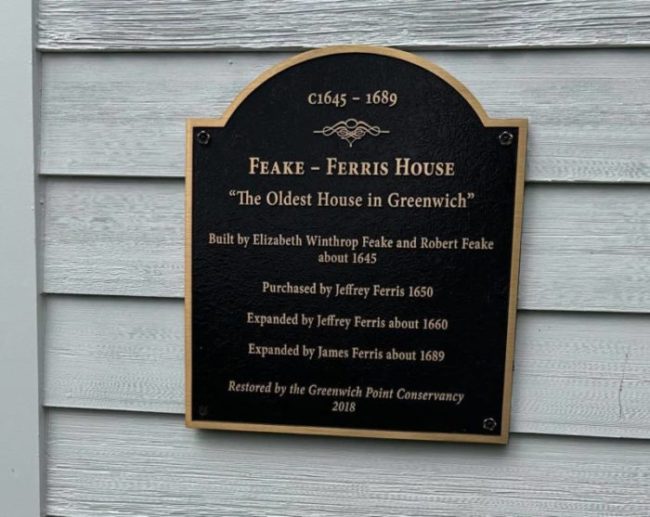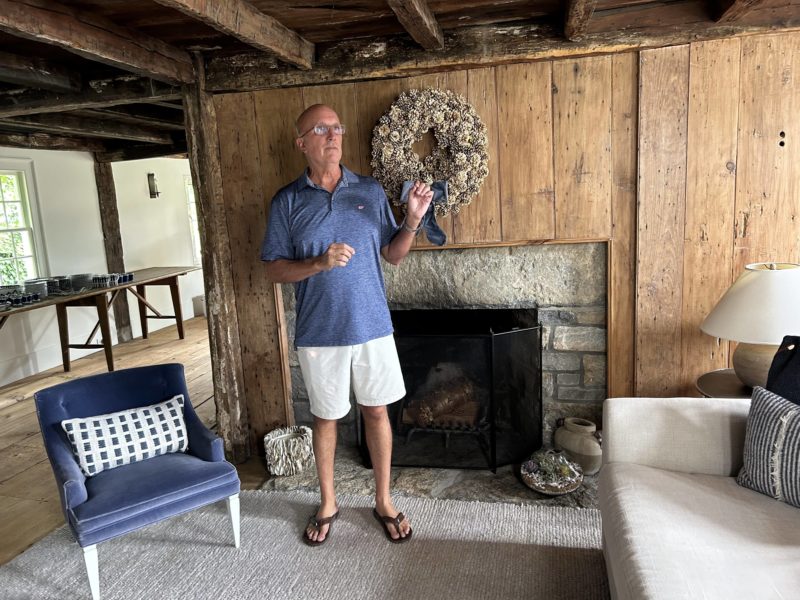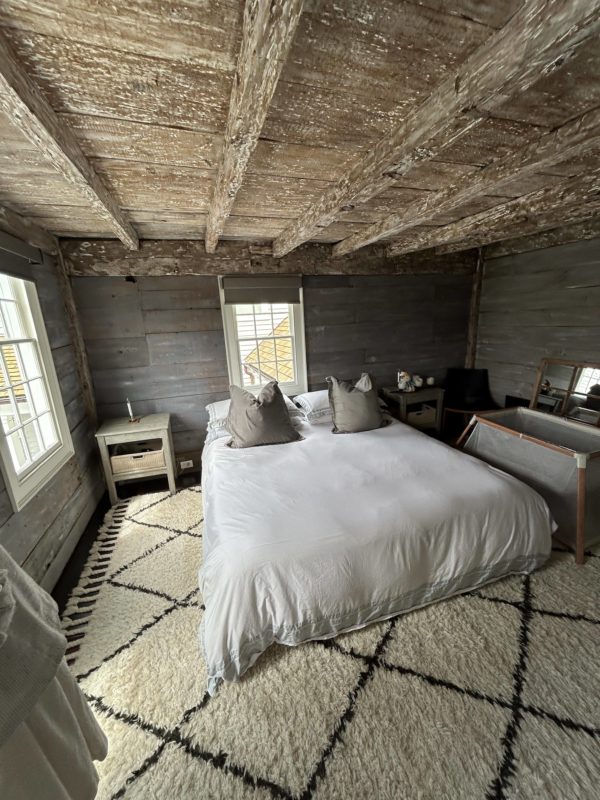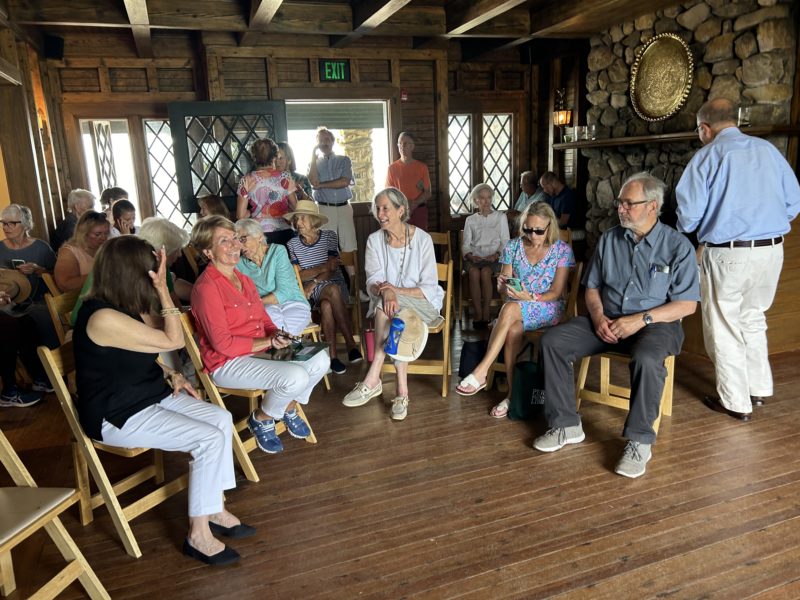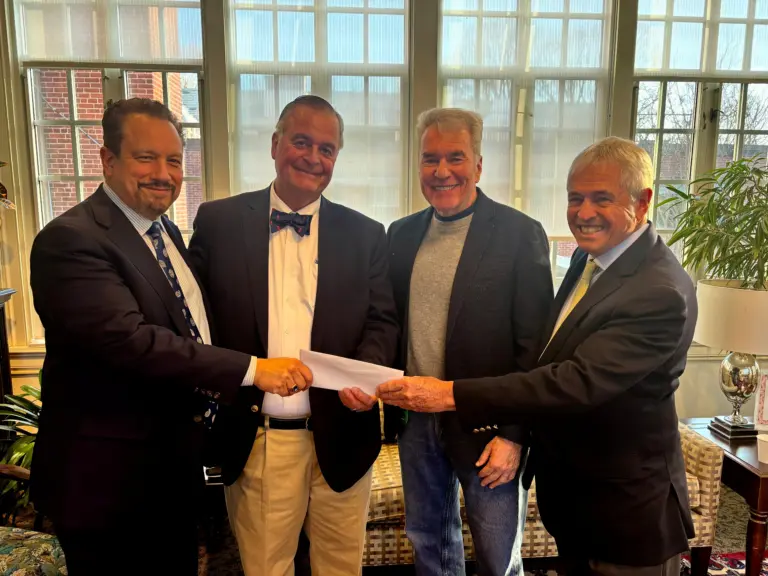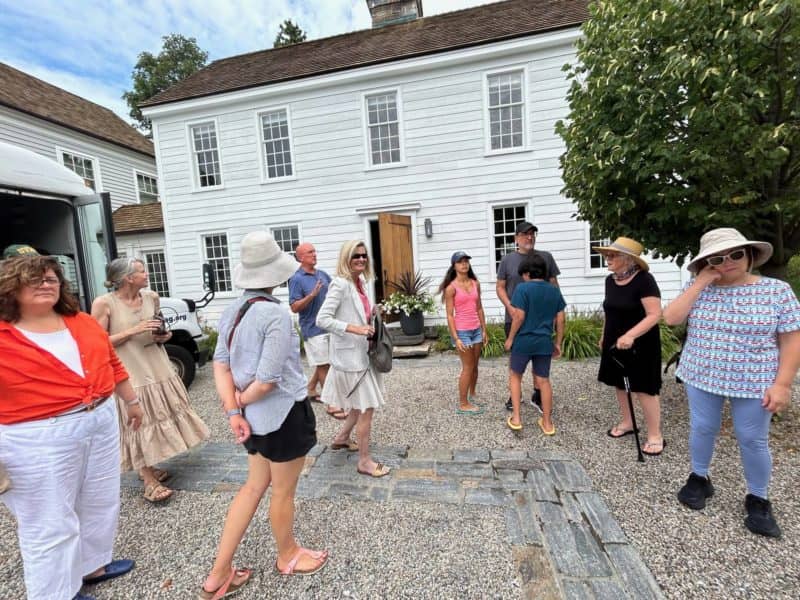
By Anne W. Semmes
There was an impressive cast of characters participating in last Thursday week’s celebration of the 384th anniversary founding of the European settlement of Greenwich. There was no reenactment of that pivotal landing of a small ship on Greenwich Point on July18, 1640 carrying Englishmen Captain Daniel Patrick, Robert Feake and wife Elizabeth Feake. Seeing that impressive layout of land they would quickly offer the resident Sinawoy Indians 25 English-colored coats for possession of that land.
But there was a rare opportunity given to the 120 attendees by organizers, the Greenwich Historical Society and Greenwich Pont Conservancy to tour the very first house of that English settlement, now called the Feake-Ferris House, circa 1645.
From the hosting Innis Arden Cottage Conservancy President Chris Franco steered the first group of attendees onto the shuttle bus transporting them up street to the 17th century white clapboard house, newly restored by the Conservancy. Arriving they were welcomed by Sue Baker, Conservancy board member, directing all to follow her to the house’s basement.
Basement tour of Feake-Ferris House
Shocked were many to learn how that Feake couple had managed to live for two years in that underground basement. “They literally dug it out and that worked because it was open to the marsh,” said Baker. “The cement floor was made of the silt from the marsh…They did live through all the seasons just here…And out the door they accessed a fire, kind of like living in a teepee.”
“So, if you go upstairs,” Baker continued, “Look at the floors, insulation has been put in but they were paper thin… you could have fallen through…when you think how primitive everything was in 1640.”
Baker had also told of the tragic life of Elizabeth Feake, who as a child had worked in an apothecary shop in London. Eager to leave London, she married young to her first cousin Henry Winthrop, son of John Winthrop, Governor of the Massachusetts Colony, but Henry drowned en route to the colonies. Young mother Elizabeth bravely made her way to the New World, soon marrying Robert Feake who would succumb to mental illness.
Chris Franco took up the tour on the first and second floors, the one room-atop-one room [but with added additions]. The living room has a handsome wood beamed ceiling. “And when we were doing our restoration,” he said, “A lot of it involved peeling back layers…There were probably four layers of siding on the outside of the house. Same thing inside. The fireplaces had been removed, so we rebuilt them…we knew exactly where they were…The floors are original, the ceiling, the beams.” He cited the wide planked floors as chestnut, the paneling of pine.
America’s oldest glass window
A great discovery in that peeling back was a window he pointed to. “This window had been encapsulated in a wall for 200 years…So, in the colonial first period homes, they had generally casement windows…the sash windows were introduced around 1689, 1690…So, as far as we’ve done research, it’s the oldest window with original glass in America.”
Franco also shared history. “So, when the original deed was signed (to be read later at the following Founder’s Day ceremony), it was Elizabeth’s particular purchase – she owned Greenwich Point. And so, she was one of the earliest female landowners in the New World.”
But, alas, in 1650, Elizabeth, having parted from the deranged Mr. Feake, and with a new partner (William Hallett) was forced to relocate to New Amsterdam (New York), thus sold her house to the Ferris family that would own it for “a couple of hundred years.” And “Essentially what you see today is the 1689 version of the house.”
On the shuttle ride back to Innis Arden Cottage, Greenwich attendee Stan Godoff shared his takes. “The second floor was light and bright, and the wood ceilings had a beautiful patina.” But he found the basement “incredibly small, incredibly dark. It’s a testimony to how adaptable a human being can be to live in such a small dark place.”
The celebratory program was kicked off by Bea Crumbine, Greenwich’s long serving Ambassador for the First Selectman – Fred Camillo standing by. “Our town established Founder’s Day to acknowledge the European settlement of Greenwich in 1640,” she began, “But it’s very important to be aware that the land that we call Greenwich Point was originally the home of the Lenape (Native Americans) who survive today in tribal nations in New Jersey, Wisconsin, Oklahoma, and Ontario.” She then welcomed Camillo,” who will read a proclamation.”
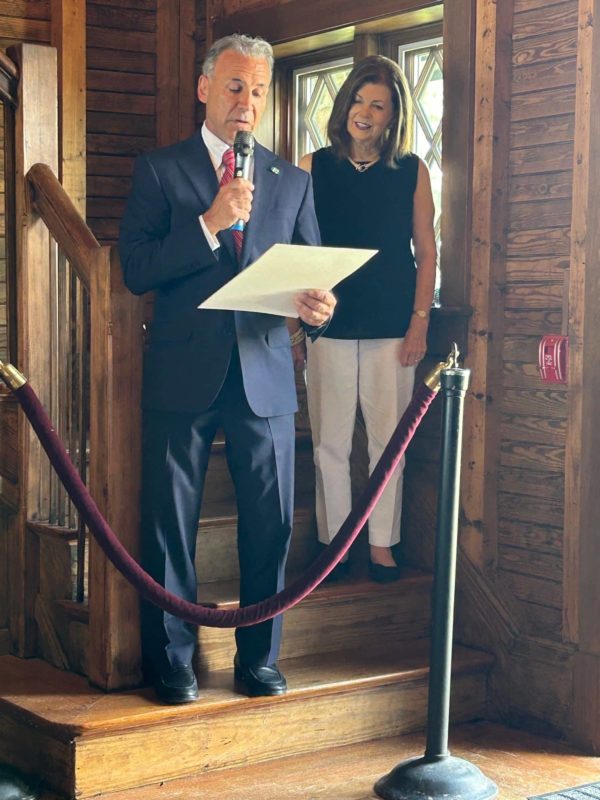
Camillo’s Town Proclamation of Founder’s Day
“Whereas on July 18, 1640, Watertown, Massachusetts neighbors Robert Feake and Daniel Patrick jointly purchased land in Old Greenwich from the local Munsee Indians. And whereas the Munsee agreed to the occupation of their land in exchange for 25 coats of cloth – and even in today’s dollars, that would be a fight with the BET!” he exclaimed, then continued, “And whereas the small and exceedingly beautiful peninsula was purchased in 1944 by the Town of Greenwich as a preserve park and beach for all to enjoy. And whereas the preservation of Greenwich Point’s natural beauty and history is emblematic of the town of Greenwich’s respect for environmental heritage and the rich tapestry of our history. Now therefore, I Fred Camillo, the First Selectman of the Town of Greenwich do hereby proclaim July 18, 2024, as Greenwich Founders Day.”
There was more humor and honoring but it was time for Livvy Floren, former State rep. to read out that deed, that English/Native American bill of sale. “We Amogerone and Owenoke, Sachems of Asamuck, and Rammatthone and Nawhorone, Sachems of Patomuck, have sould unto Robert Feaks and Daniell Patricke all their rights and interests in all lands between Asamuck and Patomuck Rivers…except the neck of land called by the Indians, Monakewego, by us Elizabeth Neck. The Neck is a particular purchase of Elizabeth Feaks, wife of Robt Feaks… They are to enjoy all rivers, islands, and natural amenities of the designated places. The Indians shall not fish within a mile of any English homestead, nor invite or permit any other Indians to settle down in ye forementioned lands…”
Christopher Shields cites pioneering first women of Greenwich
But the last historical words would come from Christopher Shields, Curator of Library and Archives at the Greenwich Historical Society. He began, “I’m going to speak briefly about the very eventful life of one of the earliest Europeans to call Greenwich home, Elizabeth Fone Winthrop Feake Hallett.” He continued, “Elizabeth showed independence and ability from the very start. Her mother passed away when Elizabeth was only 11 years old, and she assumed responsibilities in her father’s apothecary shop. She carried this independent streak into affairs of the heart, marrying her first cousin, Henry Winthrop, against her family’s wishes…
“She bravely chose to relocate to the New World as a single mother… She used her own money to purchase land in her name, and this was not looked on well by Puritan society… After Robert Feake abandoned her, she married William Hallett…without definitive evidence of a divorce…her action was considered adultery, and she could have paid with her life if it wasn’t for her being the niece of Governor John Winthrop. Nevertheless, the extent of the scandal forced Elizabeth and William to flee Greenwich….”
Shields also pointed to the importance of Elizabeth’s friendship with Anna, the Dutch wife of the “notorious” Captain Daniel Patrick, “who was also part of this founding contingent in many accounts. Anna faced similar challenges including an unpredictable husband…And also like Elizabeth, she had the responsibilities of motherhood…she had four children in her care.”
So, Shields concluded with his appreciation for “the chance today to talk briefly about two people who played an important role in the founding of Greenwich” as well as a few others he would describe who had carried on “the pioneering example set by these first women of Greenwich.” And
“Founder’s Day is an opportunity to remember that history is never a closed book.”
